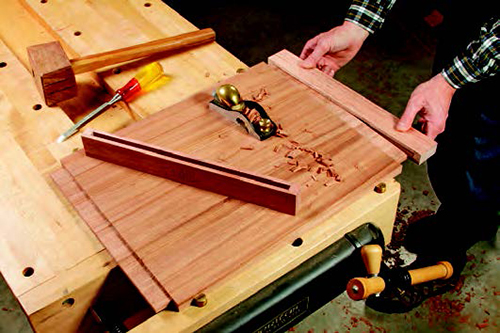
A recent piece of furniture I built has had some problems. I joined three pieces of wood together to make the top of a nightstand. These were 6″ wide pine boards joined on their ends with wood glue followed by clamping. I alternated the grain in hopes of preventing warping. But after hand planing the boards, warping started and ruined the flatness of the boards. Please give me some tips.
Lee Grindinger: Your wood was not adequately dry. If you purchased your pine from a lumberyard that sells construction lumber, the moisture content was higher than the acceptable limits for wood used in the construction of furniture. Wood used for furniture is generally dried to around 7% moisture content. Lumber dried for construction varies from 12% to 18% and even higher as it leaves the kiln.
You can do a couple of things to avoid this problem in the future. If you get your stock from a lumberyard that sells construction lumber, allow it to dry for several weeks in a heated space similar to the final destination for the piece you’re building. Stack it or lean it against the walls in such a way as to allow air movement all the way around each piece. Secondly, you can buy your pine from a hardwood dealer. Look in the yellow pages for “hardwoods” and inquire there about pine. Generally, dealers that sell hardwoods also sell pine and other softwoods that have been dried to the proper moisture content. The cheaper alternative will probably be the construction lumber you finish drying yourself but do inquire about the properly dried lumber from the hardwoods dealer as the cost difference may not be very much. Ask the pointed question “What is the moisture content of this pine?” as you shop. It should be 6% to 8% for furniture applications. If the lumber contains more moisture than that you’re rolling the dice again.
Michael Dresdner: Alternating flat sawn boards that are likely to cup means you will have a washboard instead of a bowl — each board will still cup, but because they alternate, the overall effect will S shaped instead of U shaped. Gluing them up that way will not, however, prevent each separate board from cupping. In the future, you can use narrower boards (cupping will be less noticeable), or better yet, choose more stable wood. Some types of wood move less, and in almost all cases, quarter sawn or “vertical grain” (VG) wood will move, but not cup unless the boards are misbalanced. It goes without saying that when finishing, balance the boards by sealing both sides of the wood if the board will be exposed, as is possible on a nightstand.





